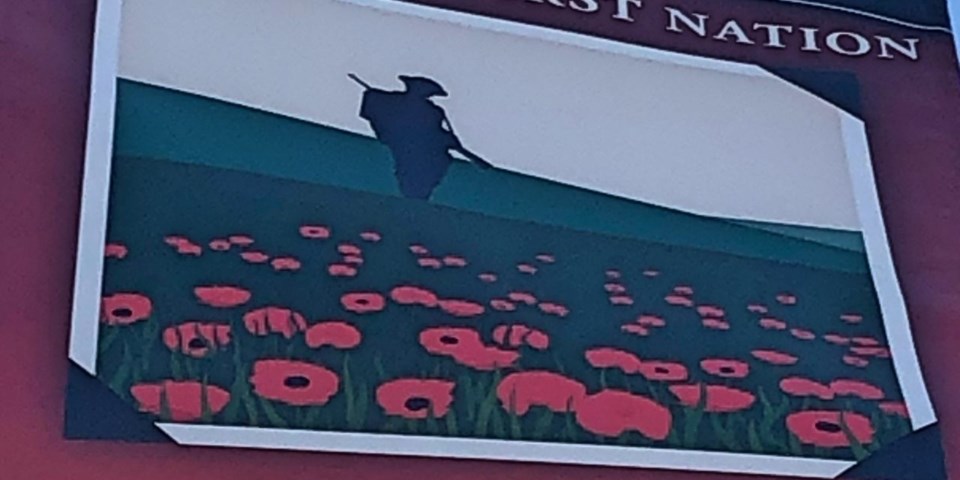The First World War began in 1914 when Austria-Hungary declared war on Serbia, Russia. Canada was called on to join the fight. According to Veterans Affairs Canada, more than 4,000 Indigenous Peoples volunteered to serve in uniform during this conflict.
Maurice Isaac of Shuswap Band, whose image can be seen on a downtown banner, was one of these men. Some history books say Indigenous veterans had to overcome many challenges when first enlisting, such as learning a new language, travelling great distances, and adapting to cultural differences. But the truth was Indigenous Peoples in Canada were no stranger to challenges.
With a second Truth and Reconciliation Day here in Canada, more have become educated about the horrors that went on in residential schools such as St. Eugene’s, which operated from 1890 to 1970. Many veterans from Shuswap Band and ?akisq?nuk First Nation would have been once forced to attend that school.
During a time when Canada was not doing right by First Nations Peoples, thousands and thousands of Indigenous men still stepped up and volunteered to do right by their country by fighting for it, their land and their people. Every man and woman who has served in the military has shown great honour. During this era, when the Canadian government questioned the value of Indigenous culture, Indigenous men did more than prove their value; they displayed true character.
After Hitler’s invasion of Poland in 1939, the second world war quickly broke out and escalated once Great Britain and France declared war on Germany. During this war, which did not end until 1945, more than 3,000 First Nations Peoples, and a countless number of Métis, Inuit and other Indigenous recruits, served in uniform with the Canadian army. It was an opportunity for many; it meant escaping the clutches of residential schools to be a part of a military reserve and serve their country.
On banners throughout Invermere are 14 World War II Indigenous veterans from this community. From ?akisq?nuk First Nation are: Isadore Michel, Abraham Michel, Anthony Fisher, Abel Capilo, Stephen B. Issac, L.J. (Jack) Stevens, William Stevens, Lucien Jimmy, Moses Jimmy, and Toby Nicholas who served in the Canadian army during World War II. Joining them from the Shuswap Band are Joe Eugene, Mathias Sam, Martin Sam, and Frank M. Sam.
Frank Sam is just one of many of Shuswap Band and ?akisq?nuk First Nation Veterans who hang proudly on banners throughout downtown Invermere, B.C. Sam left residential school at the young age of 15 to enlist in the Canadian army to serve his country. Photo By Chadd Cawson
The skills Indigenous men brought to the war were invaluable. Being skilled at hunting and spending time in nature every day from a young age made them natural marksmen. During this time many Indigenous veterans were spot-on snipers. Veteran Henry Louis Norwest, a Métis from Alberta, held a record with the Canadian Corps during the second world war (with) 115 shots determined (to be) fatal. He was awarded the bar and Military Medal for his courage under fire.
There were those who gathered information on enemy positions, referred to as reconnaissance scouts. Sergeant Tommy Prince from Winnipeg, Manitoba (where there is a monument and school named after him) was one of Canada’s most decorated reconnaissance scouts. On February 8, just outside of Littoria, Italy, Prince was spying on Germans 200 metres from enemy.
When shelling revealed his observation post at an abandoned farmhouse, cool under pressure, Prince acted swiftly, donning civilian clothes and picking up a hoe, pretending to be a farmer. This enabled him to continue reporting what he saw, allowing all four German positions at these locations to be destroyed. His bravery and steadfast thinking in dicey situations earned him the Military Medal.
All Indigenous soldiers who served earned a minimum of 50 decorations for their courage and commitment to take part in the war of their own free will.
The Indigenous languages that were not allowed to be spoken in residential schools were now considered an asset, as many Indigenous soldiers worked as code talkers. Messages would be sent in Indigenous languages so that they would be intercepted by an enemy. An Indigenous soldier would then translate the message back in English to who was intended.
According to the history books, some of the more popular Indigenous languages used in both world wars were Navajo, Ojibwe, and Cree. Using many different terms to send codes secretly, one common example was using ‘tortoise’ in one of many Indigenous languages; it was used to describe a tank. Everything had its own code.
Charles Checker Tomkins from our neighbouring province, Alberta, is noted as a famed code talker who relayed sensitive information in Cree. He is just one example of many who lent their language to make a difference, yet it made no difference in allowing them to be spoken in residential schools that continued to run 25 years after the second world war ended.
It is important to remember all veterans and those who have served over the years. But on our path to Truth and Reconciliation let us all also remember the invaluable contributions of Indigenous soldiers in both world wars, during a time when the Government of Canada did not see their value outside of it.



